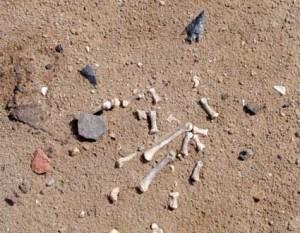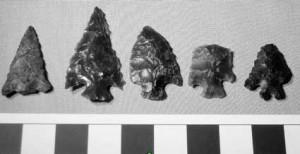Blake De Pastino
Source - http://westerndigs.org/800-year-old-camp-found-in-oregon-sand-dunes-poses-migration-mystery/
An odd assemblage of pottery, stone points, and other artifacts found among the sand dunes of southern Oregon is posing a “conundrum” for archaeologists.
 Artifacts including stone points, pottery sherds, and animal bones, as they were found at the campsite. (Courtesy Scott Thomas/BLM)
Artifacts including stone points, pottery sherds, and animal bones, as they were found at the campsite. (Courtesy Scott Thomas/BLM)
The pieces were discovered at what appears to be a hunting campsite dating back at least 800 years, in a windblown expanse of sand known as the Skull Creek Dunes.
The relics provide a “wealth of information” about the life and times of some of the Northwest’s early Numic-speaking peoples, a group that includes the modern Shoshone and Northern Paiute, said Scott Thomas, archaeologist for the U.S. Bureau of Land Management.
“This site is extremely small in size and huge in its data,” said Thomas, who discovered the site while surveying the dunes in 2014.
“Amazingly important sites do come in small packages.”
Among the finds are four beads made from shells, a stone tobacco pipe and pendant, lumps of red ochre, and a host of seeds and other parts of marshy plants that indicate a cooler, wetter climate than eastern Oregon has today.
But then there’s the conundrum: Some of the artifacts seem to come from different phases of history in the region, or perhaps different cultural groups — potentially upending what anthropologists understand about the history, migrations, and interactions of prehistoric Numic speakers.
 Skull Creek Dunes, Oregon, where the site was found. (Courtesy Scott Thomas/BLM)
Skull Creek Dunes, Oregon, where the site was found. (Courtesy Scott Thomas/BLM)
The pottery includes nearly 90 fragments from two vessels and a gaming piece, made from buff-colored sandy clay and decorated with fingernail marks — all hallmarks of a ceramic style used by the Shoshone from the 1400s to the 1800s, Thomas said.
“All in all, this pottery fits pretty well with Shoshone Ware,” he said.
If the dates from the site are accurate, he added, the fragments are the oldest of their kind ever found in Oregon.
“Ceramics are quite rare in southeastern Oregon,” he said.
“We have found a small number of sherds at Skull Creek Dunes in the past, but we only have one dated site in the area with ceramics. That site is dated to about 1500.”
But the campsite also turned up nine projectile points fashioned from obsidian in a narrow-stemmed style known as Rose Spring Corner Notched. And this style has been found throughout the Great Basin — but at sites that are 500 to as much as 1,200 years old, often with artifacts from other cultures.
So the projectile points found at the camp suggest an age to the site that is centuries earlier than the Shoshone pottery would indicate, Thomas said.
“The site is early for Shoshone Ware, but not for Rose Spring Corner Notched points,” he said.
Adding to the confusion, Thomas said, is the fact that three samples of charcoal from the campsite’s ancient hearth have produced three different radiocarbon dates — one from the year 847, another from 927, and a third from 1242.
“Hence my puzzlement,” Thomas said.
“Nonetheless,” he added, “all three dates are earlier than the earliest instance of Shoshone Ware in this area and also somewhat early in other places where Shoshone Ware occurs.
“That is the conundrum that we haven’t completely solved or sorted out.”
The apparent contradiction lies in what archaeologists currently understand about the history of Numic-speaking peoples.
According to prevailing theories, Numic speakers first entered eastern Oregon from their homeland in southern California about 600 years ago — almost two centuries after the Numic artifacts found at the Skull Creek campsite were made.
And, the thinking goes, the migrants brought with them tool-making techniques that resulted in distinctive artifacts. But artifacts of that style are conspicuously absent from the campsite.
Specifically, ancient Shoshone sites found throughout the northern Great Basin commonly feature a different style of projectile points, Thomas said — lighter, more triangular arrowheads with flared bases, known as Desert Side Notched and Cottonwood Triangular points.
“If Desert Side Notched points are one of the hallmarks of the Numic expansion,” Thomas asked, “why are there so few in my area, when we clearly have Numic people living here?”
One possibility, he said, is that the Desert Side Notched style was actually an invention of another group, like one of the native cultures of northern California, where the style was first identified.
 Five of the nine Rose Spring Corner-Notched arrow points. (Courtesy Scott Thomas/BLM)
Five of the nine Rose Spring Corner-Notched arrow points. (Courtesy Scott Thomas/BLM)
Meanwhile, the technology found in the Dunes — the so-called Rose Spring style — may have been the original style brought by Numic-speakers from California.
If that’s the case, then Numic migrants may have adopted new tool-making methods as they moved into the Great Basin and interacted with other groups, Thomas said.
“My theory … is that Desert Side Notched and Cottonwood Triangular points are not Numic-wide but originally spread … and were adopted by Shoshone people that just happened to make Shoshone Ware pottery,” he said.
“I’m not sure about the timing of this, but it had to have happened between 1450 and 1800.
“Since the pottery from [the campsite] is earlier than these two dates, it may be that the pottery is a very early Shoshone Ware,” he noted.
In that case, the site and its ceramics may pre-date the time when Numic migrants began to adopt the new Desert Side Notched style.
Thomas and his colleagues will return to Skull Creek Dunes next year to investigate the site further.
Among the clues they’ll be looking for will be signs of structures, which would suggest that the location was more than a temporary campsite.
“What we would be looking for is small post molds where the supports of a wickiup or some similar structure remain,” he said.
But any new clues would be welcome, if they help clarify who used the site, and when, he added.
“At this point, the dates for this site have created this mystery,” he said.